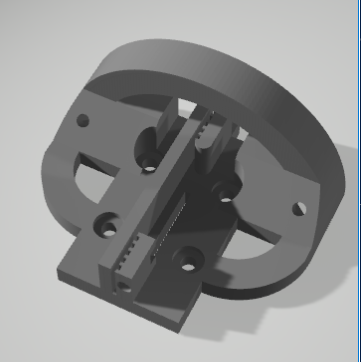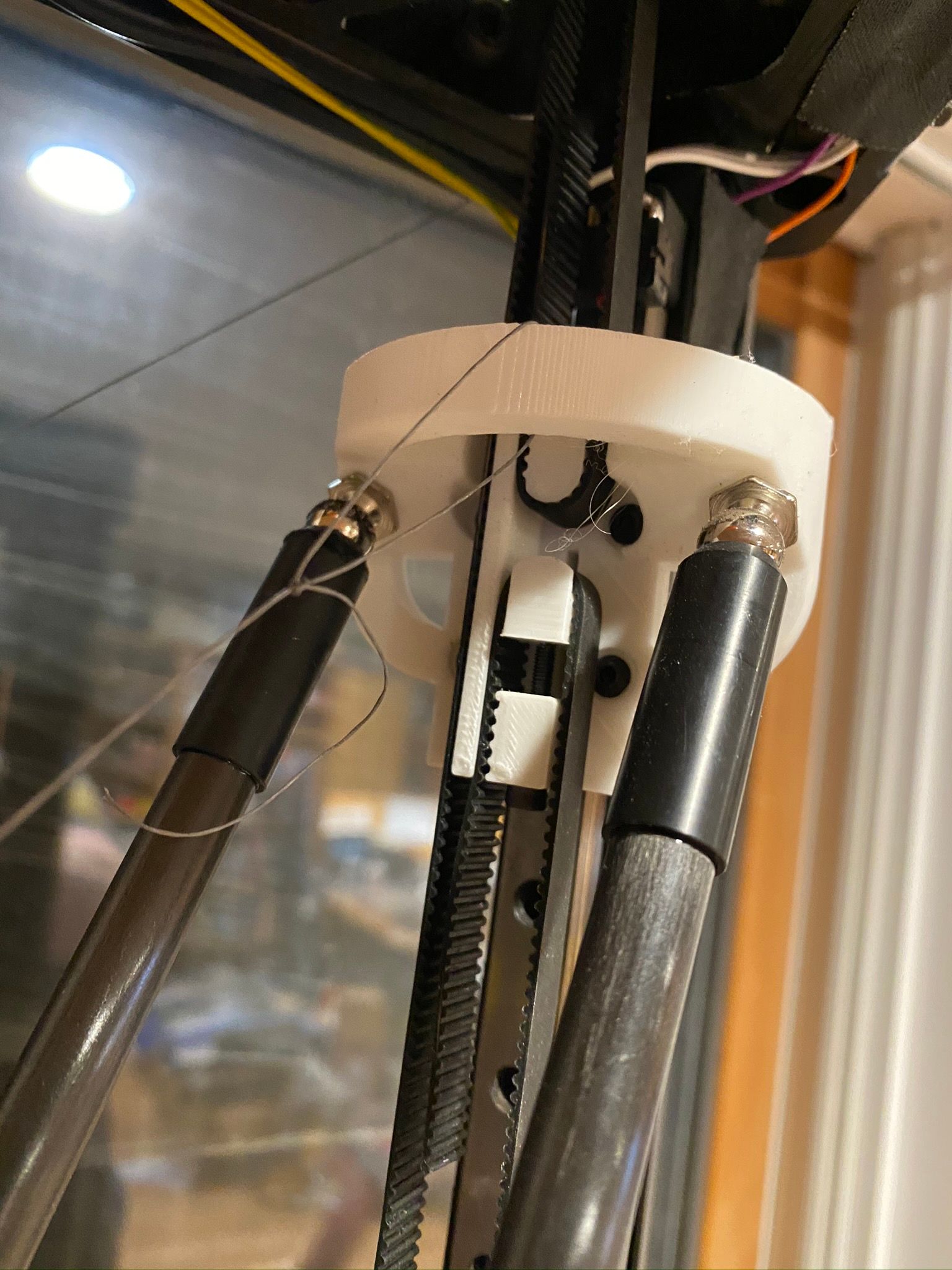Delta printer belts and 16 tooth pulleys
-
@blt3dp My belts are Gates 2GT belts (the ones from E3D and actually manufactured by Gates Unitta.) However, the thickness of the belt shouldn't matter as the belts are in a loop with the teeth inside, so only the distance between the edge of the teeth should matter. That won't change if the belts are 1.5mm thick or 5mm thick.
If it matters, my pulleys are also 2GT Gates purchased from E3D (via filastruder.)
My idlers are the same 16T profile.
(2GT/GT2 belts have a 2mm profile that dictates the diameter of any toothed pulley/idler with a certain number of teeth. The only way the diameter can be different would be if the tooth profile didn't match or if there were more teeth. I have a ton of cheap generic 16T pulleys and idlers, and they all are within 0.2mm diameter of each other. )
-
@garyd9 said in Delta printer belts and 16 tooth pulleys:
@blt3dp the thickness of the belt shouldn't matter as the belts are in a loop with the teeth inside, so only the distance between the edge of the teeth should matter. That won't change if the belts are 1.5mm thick or 5mm thick.
Yah, you're right there. I spaced it. And actually looking at my model that was originally created from the Robotdigg drawings of those carriages and then tweaked upon acutal measurement of the parts, the space between the inner side of the vertical wall on the left and the outer on the vertical wall on the right is 10.7 mm. Which if you subtract 1x the thickness of the belt (1.38 mm), that leaves 9.39 mm. I'd agree with you, it should rub.
-
You don't see complaints because the rubbing doesn't matter (debatable... see below).
I designed my own carriage adapters when I built my large-ish delta. As an aside, this was probably foolish and I should be running the Robotdig/PCB combo that is recommended. Nonetheless, my home-made ones have been on my printer for 4 years now, hundreds of prints.
The parts between the belts total to about 11mm. They rub. It does not seem to make any detectable difference to the operation of the printer. I am sure they cause a geometry error or asymmetry of some sort as the "wide spot" in the belts moves up and down. This seems to be a small enough error to not be detectable.
The perfectionist in me hates to be typing this post... the pragmatist in me says 'meh'.

-
It's a known problem. The standard carriage adapters are designed for 20t pulleys and idlers. I designed my own adapters for use with 16t pulleys and idlers.
-
I'm surprised this would be a "common" issue. I'd think that the belt teeth rubbing against a part of the carriage would not only introduce vibrations, but would also eventually wear down the teeth on the belt. That's even more amazing when I read about people people who swap from smooth idlers to toothed idlers to prevent vibration and wear on the belt.
What I really had expected from starting this thread was either someone pointing out that my math was wrong (and then explaining how) or telling me that most carriages offset the tensioner to one side a bit to prevent rubbing.
Even in the picture in the first post showing @dc42's carriage, it appears that there's a tiny seperation on the right between the carriage and belt (but it's hard to be certain.) In the same blog entry I pulled that picture from, he said he was using 16T pulleys...
@bartolomeus, you mentioned that you designed your own adapters. Would you be willing to share the model? I'll probably end up designing my own as well, but I'd love ideas on how others have handled the issue.
Thanks
Gary -
It is not a common issue because it is a non-issue. Sort of. I suppose the angle is too shallow to "catch a tooth".
Again, the perfectionist in me hates explaining this in any way... but... it really doesn't wear. Or I would have eaten a set of belts long ago. It is typical for that big printer to print 20 hours+ a day for weeks at a time. Or 24 for five to six days straight, when it is printing something that really exploits its capacity (600mm dia, 620 Z). It has been up for about 4 years. Same belts. No sign of wear, dust, or even rounded corners on the carriages.
And just to REALLY repeat: I'd encourage anyone to have 8mm or less for all the bits between the belts. I don't want to "defend" having it "wrong". I'm just pointing out that people don't post about it much because, when it is "wrong", the effects are very subtle, if any.
-
@garyd9 here it is, nothing special and it doesn't have a tensioning system: https://www.thingiverse.com/thing:3167267
-
Are you ok @Danal? Something seems to be rubbing you the wrong way.
-
Hmmm... tone is hard when just typing. Nothing is wrong as far as I know, just really trying to balance perfection and pragmatism.
Annnnd I always have a tendency to over-explain.

Thank you very much for asking!
-
@Danal
 It was a play on the belts rubbing.
It was a play on the belts rubbing. -
WOOOOSH!!! Man, that went right over my head!!! And I normally catch those.
Good one!
-
@Phaedrux his teeth are on edge...
-
-
After reading this thread, I'll acknowledge that a belt rubbing might not matter and everything works "good enough."
However, a person can also argue that using an 8 bit board to control a delta with 1.8 degrees stepper motors is also "good enough." Or that if rod spacings are within 2/10th of a mm of each other, it'd be good enough.
However, once I know about a potential issue, I can't help but to want to solve it. I suspect that most people currently posting in this thread are similar...
So, I've scoured thingiverse for some type of belt tensioning system idea that is adjustable, wouldn't rub, and that I can use with my own model. So far, in 2 hours of searching I've only found one. (Keep in mind that thingiverse is painful to search as well as incredibly slow - and that I have to actually download STL files, and import them into fusion 360 to properly measure the gaps.)
Here's a carriage designed for use with v-slot wheels that uses a belt tensioning "system" that is only attached to the carriage by a single M3 bolt and leaves plenty of room for the "return" belt: https://www.thingiverse.com/thing:2183347
Being that the only attachment between the carriage and the tensioner is a single M3, it should be easy to fit this type of system on anything with minimal effort. I have to admit that I'm trying to find something wrong with this tensioning "system." It just seems too simple and not nearly fancy enough to work properly.
-
Hmmm... if they are that rare, then here is one more. This is the one I've been running, modified to be 8mm core. This MIGHT cause issues with the 3mm tension screw; may have to go to 2mm screw.
Photo is of an old "fat core", just to make the traveler/tension easier to understand.
Carriage for HWIN 55mm Mag 9mm belt - Traveler.stl
Carriage for HWIN 55mm Mag 9mm belt V6.stl


-
@Danal said in Delta printer belts and 16 tooth pulleys:
Hmmm... if they are that rare, then here is one more. This is the one I've been running, modified to be 8mm core. This MIGHT cause issues with the 3mm tension screw; may have to go to 2mm screw.
As you suspected, thinning out the core creates a problem with the M3 tension screw. A 3mm hole in a 4mm block of plastic doesn't work well.
What might work instead is to instead thin out the "wall" that runs the entire length of the carriage (which is 3mm thick in the stl's you posted) to 2mm and then thicken the traveler and section where the M3 screw goes up to 5mm (from 4mm in the files you posted.) That might require shifting everything to one side.
How does the traveler work on this? Do you glue the nut in place on the carriage?
I might mock up something similar tonight or tomorrow and see how it works out.
-
The nut tends to stay in place.
This is all openSCAD by the way, I can post those files as well. I did not, because the forum won't accept that file extension and I will have to zip them or something.
I'll change the various widths in a few min.
-
@Danal said in Delta printer belts and 16 tooth pulleys:
I will have to zip them or something.
It won't take zip files either. You'd have to change the extension to .txt or something or host it elsewhere and link it.
-
I have added .scad to the list of allowed file extensions.
-
THANK YOU!! What a rapidly delivered 2020 gift!
